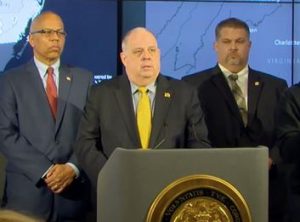Dedicates $50 Million in Funding Over 5 Years, Taps Senior Emergency Management Advisor to Lead Effort
 Governor Larry Hogan today signed Executive Order 01.01.2017.02 declaring a State of Emergency in response to the heroin, opioid, and fentanyl crisis ravaging communities in Maryland and across the country. This declaration activates the governor’s emergency management authority and enables increased and more rapid coordination between the state and local jurisdictions. The governor, along with Lt. Governor Boyd Rutherford, also announced $50 million in new funding to address the crisis, as well as the appointment of the governor’s senior emergency management advisor Clay Stamp to lead the state’s coordinated effort to combat the crisis.
Governor Larry Hogan today signed Executive Order 01.01.2017.02 declaring a State of Emergency in response to the heroin, opioid, and fentanyl crisis ravaging communities in Maryland and across the country. This declaration activates the governor’s emergency management authority and enables increased and more rapid coordination between the state and local jurisdictions. The governor, along with Lt. Governor Boyd Rutherford, also announced $50 million in new funding to address the crisis, as well as the appointment of the governor’s senior emergency management advisor Clay Stamp to lead the state’s coordinated effort to combat the crisis.
Governor Hogan and Lt. Governor Rutherford made the announcement at the Maryland Emergency Management Agency (MEMA) Emergency Operations Center in Reisterstown, MD. They were joined by Governor’s Office of Crime Control & Prevention Executive Director Glenn Fueston, MEMA Executive Director Russ Strickland, Department of Human Resources Secretary Lourdes Padilla, Department of Health and Mental Hygiene Secretary Dennis Schrader, Department of Juvenile Services Secretary Sam Abed, Maryland State Police Superintendent Colonel William Pallozzi, Dr. Sylvia Lawson of the Maryland State Education Department, and emergency management officials from jurisdictions across the state.
“The fact of the matter is that people all across Maryland, and across our country, are looking for answers when it comes to this heroin and opioid epidemic. Too many families know the devastation caused by this crisis and the death toll is climbing,” said Lt. Governor Rutherford. “Ultimately, this is about saving lives, and it will take all of us working together in a collaborative, holistic approach to achieve that.”
The State of Emergency declaration is a result of the initial findings of the Opioid Operational Command Center (OOCC) established by the administration in January to facilitate greater collaboration among state agencies, including health and human services, education, and public safety entities. The OOCC’s work made it clear that the state needed greater flexibility to activate emergency teams in jurisdictions across the state and engage local communities. The governor’s executive order delegates emergency powers to state and local emergency management officials, enabling them to fast-track coordination among state and local agencies and community organizations, including private sector and nonprofit entities to ensure whole-community involvement.
The governor also announced a supplemental budget of $50 million in new funding over a five-year period to support Maryland’s prevention, recovery, and enforcement efforts. Rather than locking us into inflexible spending through statute, the governor’s plan will provide flexibility to public health and safety professionals in order to address this emergency.
Finally, the governor announced that he has tasked his senior advisor for emergency management, Clay Stamp, to oversee this coordinated effort. As Executive Director of MEMA, Stamp managed the administration’s response to the Baltimore riots in 2015, and has proven experience with efficiently and effectively facilitating efforts between state, local, and community-based entities to respond to crises in real time.
“As an emergency management professional, it gives me great honor to have been chosen to lead such an important effort, and to serve next to the many dedicated and highly capable people who are working to eliminate the impact this crisis is having on the people of Maryland,” said Stamp.
In January, the governor and lieutenant governor announced the administration’s 2017 Heroin Prevention, Treatment, and Enforcement Initiative, a multi-pronged strategy to tackle the evolving threat of heroin and opioid addiction. The initiative includes three important pieces of legislation: the Prescriber Limits Act of 2017, the Distribution of Opioids Resulting in Death Act, and the Overdose Prevention Act, as well as important budgetary actions, including $4 million in new funding to address the crisis.
Since forcefully recognizing and identifying the rapidly growing opioid and heroin epidemic during the 2014 gubernatorial campaign, Governor Hogan and Lt. Governor Rutherford have made proactively addressing this crisis a cornerstone of the administration’s agenda. In 2015, Governor Hogan signed an executive order creating the Heroin and Opioid Emergency Task Force, chaired by Lt. Governor Rutherford. The task force developed 33 recommendations focused on prevention, treatment, and enforcement to aggressively combat the opioid and heroin crisis.
The administration has also addressed the crisis at the regional and national levels. In October 2016, the governor signed a regional compact with Virginia and Washington, D.C. leadership to coordinate the region’s response to the crisis. This past weekend, the governor discussed the crisis with fellow governors and senior federal officials at the National Governor’s Association winter meeting, and raised the issue as a top priority for the state in a meeting with Maryland’s federal delegation convened by the governor in February.


